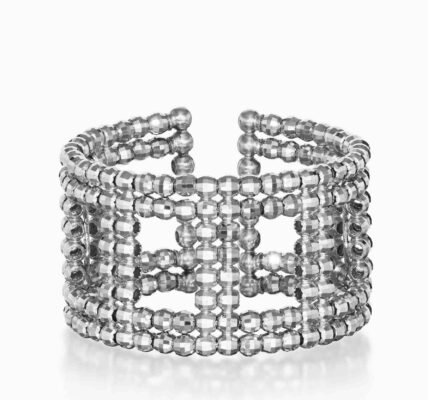In 2023, UK hallmarking experienced a 17.6% decline, influenced by various economic and market dynamics. Post-Brexit trade uncertainties, increased tariffs, and currency fluctuations have disrupted operations and raised costs.
Additionally, changes in consumer behaviour, with a shift towards more affordable, non-hallmarked jewellery and e-commerce, have further impacted demand. Industry challenges, such as regulatory changes and competition from emerging markets like China and India, have strained smaller businesses.
The sector also faces the need for significant investments in technology for digital hallmarking and blockchain to remain competitive. These factors collectively are reshaping the hallmarking industry.
Article Contents
- 1 Main Highlights
- 2 Analysing the Decline
- 3 Changes in Number of Items Hallmarked in the UK Between 2022 and 2023
- 4 Economic Factors
- 5 Consumer Behaviour Changes
- 6 Precious Metals Market Trends
- 7 Future of UK Hallmarking
- 8 Frequently Asked Questions
- 8.1 What is Hallmarking and Why is it Required in the UK?
- 8.2 How Does Hallmarking Affect the Authenticity of Precious Metals?
- 8.3 What Are the Legal Implications of Not Hallmarking Jewellery in the UK?
- 8.4 How Can Consumers Verify if an Item Is Properly Hallmarked?
- 8.5 Which Organisations Are Responsible for Hallmarking in the UK?
- 8.6
- 9 Conclusion and Summary
Main Highlights
- Economic factors, including uncertainties surrounding Brexit-related trade and tariffs, have contributed to the 17.6% decline in UK hallmarking in 2023.
- Changes in consumer behaviour towards more affordable, non-hallmarked jewellery have reduced the demand for hallmarking services.
- Regulatory changes have resulted in increased compliance costs and operational complexities, further burdening the hallmarking industry.
- Technological advancements such as digital hallmarking and blockchain require significant investments, impacting industry profitability.
- Emerging markets and alternative materials have heightened competition, posing challenges to the UK hallmarking sector.
Analysing the Decline
The UK’s assay offices were shocked to see a 17.6% decline during 2023 after a rise of 12.2% in the number of items sent for hallmarking across all four of the British hallmarking offices in 2022.
As might be expected, not all items were affected in the same way. The following table, using Assay Office data shows a breakdown of the changes with 24K gold showing an increase of over 25% and 800 silver a decline of over 66%.
Overall, a total of 8,031,340 pieces of jewellery were hallmarked in 2023, in comparison with 9,745,285 in 2022, a decline of 1,713,945 pieces.
Changes in Number of Items Hallmarked in the UK Between 2022 and 2023
| Metal | Purity | Change in Hallmarking Numbers |
|---|---|---|
| Gold | 999 | +25.1% |
| Gold | 375 | -16.5% |
| Silver | 999 | +23.9% |
| Silver | 958 | +30.6% |
| Silver | 925 | -22.8% |
| Silver | 800 | -66.2% |
| Platinum | -7.9% | |
| Palladium | +2.6% |
The 17.6% decline in UK hallmarking in 2023 can be attributed to a combination of economic factors, changes in consumer behaviour, and industry-specific challenges. A significant factor has been regulatory changes within the industry. New policies to modernise hallmarking practices have inadvertently increased compliance costs and operational complexities for jewellers. While these changes are intended to enhance transparency and consumer protection, they have also posed barriers for smaller businesses struggling to adapt.
Additionally, technological advancements have played a crucial role. The rise of digital hallmarking and blockchain technology offers increased traceability and security but requires substantial initial investment. Many traditional jewellers find it challenging to keep pace with these technological demands, leading to a decline in hallmarking volumes.
Furthermore, industry competition has intensified, with emerging markets and alternative materials gaining popularity. Synthetic diamonds and lab-grown gemstones, for instance, are becoming more accepted, reducing the demand for traditionally hallmarked precious metals. This competitive landscape forces UK jewellers to innovate continually, often reallocating resources away from hallmarking processes.
Collectively, these factors illustrate the multi-faceted challenges facing the hallmarking industry in 2023.
Economic Factors
Economic factors have significantly influenced the 17.6% decline in UK hallmarking, compounding the industry’s existing challenges. One of the most important contributors to this downturn is the UK’s cost of living crisis, exacerbated by the impact of Brexit, which has created a complex web of trade uncertainties and regulatory changes. The departure from the European Union has led to increased tariffs and more stringent customs checks, disrupting the seamless flow of goods and materials essential for hallmarking.
Moreover, currency fluctuations have further exacerbated the situation. Since Brexit, the British pound has experienced considerable volatility, affecting import costs and pricing strategies for jewellers and manufacturers. This unpredictability in exchange rates complicates long-term planning and budgeting, making it more challenging for businesses to maintain profitability.
Trade policies have also played a significant role in this decline. The renegotiation of trade agreements has led to less favourable conditions for the UK, impacting the cost and availability of raw materials required for hallmarking. New trade barriers and higher compliance costs have strained smaller businesses, many of which are pivotal to the hallmarking industry.
Consumer Behaviour Changes
Changes in consumer behaviour have significantly impacted the decline in UK hallmarking, mirroring broader trends in purchasing preferences and economic caution. Consumers are becoming more and more drawn to the convenience and variety that digital platforms offer as online shopping becomes more popular. This shift is reflected in evolving fashion preferences that emphasise affordability and accessibility, often at the expense of traditionally hallmarked items.
Additionally, the retail landscape has transitioned from brick-and-mortar stores to e-commerce, which frequently circumvents the traditional hallmarking process. This transition caters to a tech-savvy demographic and aligns with a growing preference for fast fashion and costume jewellery over investments in precious metals.
Here is a comparative overview highlighting key factors affecting consumer behaviour:
| Factor | Description |
|---|---|
| Online Shopping | Increased accessibility to a wide range of products |
| Fashion Preferences | Shift towards affordable, non-hallmarked jewellery |
| Economic Prudence | Preference for cost-saving over luxury investments |
| Retail Changes | Move from physical stores to digital platforms |
These trends illustrate a major transformation in consumer behaviour, underscoring the need for the hallmarking industry to innovate and adapt to the changing market landscape. The decline in hallmarking is not merely a statistical drop but a reflection of deeper cultural and economic shifts.
Precious Metals Market Trends
Current trends in the precious metals market reveal a clear divergence between investment demand and consumer purchasing behaviour. Investors are increasingly drawn to precious metals as a hedge against economic volatility, while consumer purchases, particularly in jewellery, have experienced a decline. This shift is driven by several key factors, including global competition, technological advancements, and stringent industry regulations.
Global competition has intensified, with emerging markets like China and India emerging as significant players in the precious metals sector. These countries contribute to the mining and production of metals and stimulate considerable consumer demand, thereby altering traditional market dynamics.
At the same time, technological advancements have improved mining operations and enhanced the efficiency of metal extraction and processing, leading to fluctuations in supply and pricing.
Industry regulations have also played a crucial role in shaping market trends. Stricter environmental and labour standards have raised operational costs for mining companies, thereby impacting the price of precious metals. These regulations promote ethical practices but also add complexity to market operations.
Taken together, these factors highlight the complex and evolving nature of the precious metals market, where investment and consumer behaviours continue to diverge in response to global and technological pressures.
Future of UK Hallmarking
Future UK hallmarking is likely to go through significant changes as a result of changing consumer preferences and improvements in digital authentication technologies. As the industry adapts to these changes, technology will play a vital role in enhancing transparency and traceability. For instance, blockchain technology could completely change the hallmarking process by providing an immutable ledger of authenticity for precious items.
Regulatory changes are also anticipated to shape the future landscape. Authorities may introduce stricter guidelines to ensure hallmarking remains robust and trustworthy in an increasingly interconnected world. These changes are designed to protect consumers and promote market confidence.
Innovations within the industry will further drive progress in UK hallmarking. From advanced laser marking techniques to sophisticated AI-driven authentication systems, the sector is set to enter a new phase of precision and reliability. These innovations streamline the hallmarking process and align with the growing demand for sustainable and ethically sourced precious metals. As technology continues to evolve, so too will the methods for ensuring the authenticity and quality of precious metals. Additionally, with the rise of labgrown diamonds in marketing, the industry will need to adapt and innovate to meet the demands of a changing consumer landscape. This means developing new ways to authenticate and distinguish between natural and labgrown diamonds, as well as finding ways to incorporate labgrown diamonds into hallmarking processes.
Embracing these changes will guarantee that UK hallmarking remains relevant, trusted, and in line with modern standards in the future.
Frequently Asked Questions
What is Hallmarking and Why is it Required in the UK?
Hallmarking, with a history spanning over 700 years, ensures that precious metals meet established international standards. In the UK, hallmarking is essential for maintaining consumer trust by guaranteeing the authenticity and quality of precious metal items. This practice protects both buyers and the reputation of the jewellery industry.
How Does Hallmarking Affect the Authenticity of Precious Metals?
Hallmarking significantly enhances the authenticity of precious metals, boosting consumer confidence and fostering market trust. It ensures quality assurance, certifying that buyers receive genuine and accurately described items, thereby promoting a reputable market environment.
What Are the Legal Implications of Not Hallmarking Jewellery in the UK?
Failure to hallmark jewellery in the UK can lead to legal penalties and fines, harming a business’s reputation. This lack of compliance undermines consumer protection and breaches trade regulations.
How Can Consumers Verify if an Item Is Properly Hallmarked?
Consumers can verify if an item is properly hallmarked by examining hallmark symbols, which indicate metal purity and origin. Understanding these symbols and consumer rights guarantees confidence in the verification process, fostering trust and informed decision-making within the community.
Which Organisations Are Responsible for Hallmarking in the UK?
The Assay Offices in London, Birmingham, Sheffield, and Edinburgh regulate the hallmarking process in the UK. These organisations are responsible for ensuring the accuracy and integrity of precious metal certification and managing the associated hallmarking fees.
Conclusion and Summary
The 17.6% decline in UK hallmarking in 2023 reflects a complex issue influenced by economic factors, changes in consumer behaviour, and evolving trends in the precious metals market.
This downward trend presents significant challenges for the jewellery industry, necessitating strategic adjustments to adapt to changing market dynamics.
Understanding these underlying causes and their implications is crucial for stakeholders aiming to navigate and mitigate the impact on the future of UK hallmarking.






